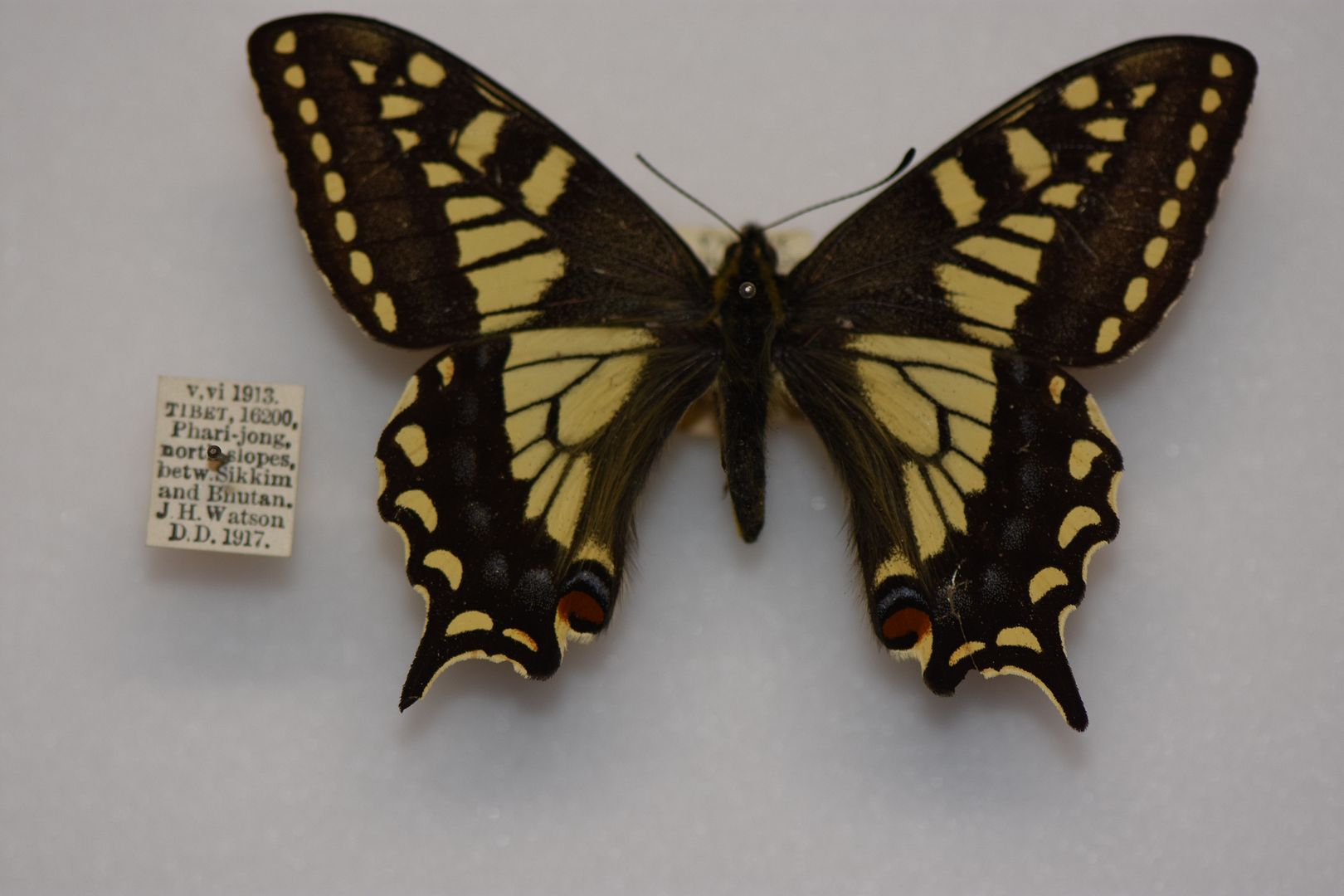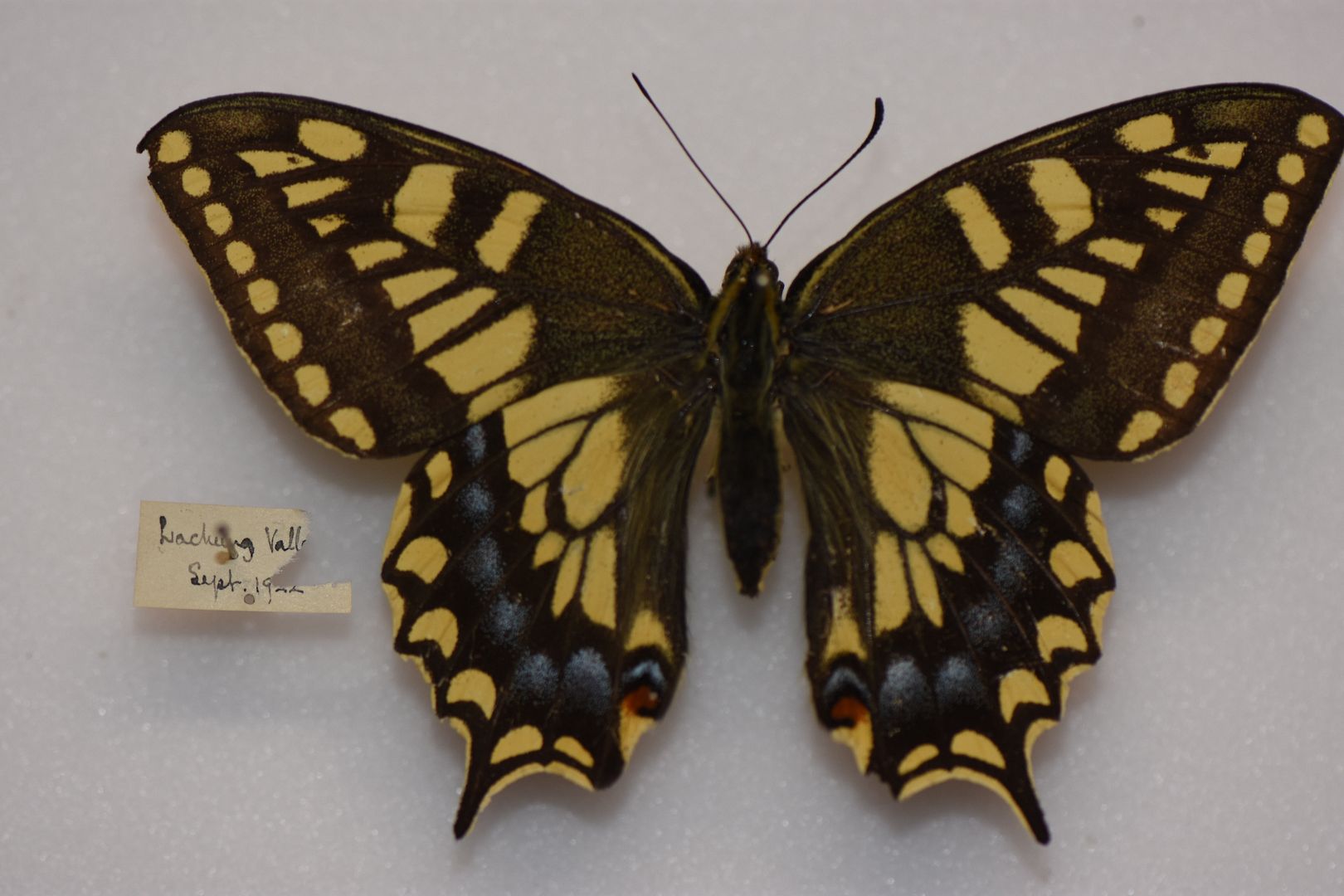|
|
Post by nomad on Nov 23, 2016 20:02:55 GMT
What is the distribution range of Papilio machaon sikkimensis Moore 1884 and the top altitude of that subspecies and what is the distribution range of Papilio machaon everesti Riley 1927. I know that the latter occurs up to 17,000 feet by the Rongbuk Glacier at the Everest base camp.
|
|
|
|
Post by Adam Cotton on Nov 23, 2016 21:14:19 GMT
Interesting question, with rather convoluted answers.
Firstly sikkimensis Moore, 1884 is a junior homonym and was replaced by hookeri Gaonkar, 1999, so that name should not be used. Probably it is not actually conspecific with Papilio machaon at all, and if that is the case everesti Riley, 1927 would be the oldest available name for the species.
What you call sikkimensis occurs from Sikkim to NW Yunnan at altitudes of about 3,500m upwards to more than 5,000m. As far as I know everesti is only known from Rongbuk, but kiyonobu and nolico, both described by Morita, 1997 from W. Tibet (5,000-5,300m) and Nyalam (4,400m) respectively will also belong to the same species, as will alpherakyi Bang-Haas, 1933 (W Gansu) and hieromax Hemming, 1934 (Qinghai). Probably there are connecting populations between these and 'sikkimensis'.
Adam.
|
|
|
|
Post by nomad on Nov 24, 2016 6:20:52 GMT
Do you mean that everesti Riley, 1927 should be considered a distinct species and that sikkimensis Moore, 1884 = hookeri Gaonkar, 1999 should be considered a synonym or a subspecies of the latter. As I understand it no separation has taken place and authors still regard them as ssp of Papilio machaon.
|
|
|
|
Post by Adam Cotton on Nov 24, 2016 11:33:38 GMT
Yes, almost all publications treat them as subspecies of Papilio machaon, although Lee, C. L. 1980 (Acta Entomologica Sinica 23(4): 427-431) separated machaon in China into 3 species: machaon, verityi and 'annae'. What he called annae is what most people still refer to as sikkimensis, and verityi is the taxon from southern Yunnan through to Manipur. In reality annae is a synonym of the long tailed lower altitude Himalayan machaon asiatica. Whether verityi is a separate species or not is questionable, but everesti PROBABLY is. More study is needed to confirm it, but the evidence currently points to this. Unlike the high altitude short tailed ladakensis in the NW Himalayas, everesti and the other taxa that are probably conspecific with it do not mate with machaon to produce intermediate populations at mid altitude. Subspecies ladakensis and asiatica do mate and there are intermediate populations in NW Pakistan, and probably NW India at about 3000m altitude.
Notably also if you look at the anal red eyespot on the machaon hindwing the red spot is bordered with blue and there is a black edge above the blue lunule. In everesti and relatives there is a black crescent separating the red eyespot from the blue, so that there are two black crescents above the eyespot, similar to many American species and subspecies of the machaon group. This character is also present in summer form hippocrates, but not spring form, and some other Asian taxa, but there are differences between them and the everesti taxa.
Lee also discussed differences in male genitalia between the three taxa he separated out as species. More work, especially DNA which has so far concentrated on European and American machaon needs to be carried out to cofirm the situation.
Adam.
|
|
|
|
Post by nomad on Nov 24, 2016 19:25:04 GMT
Below are two interesting high altitude Papilio machaon specimens. Taken at Phari Jong by J. H. Watson during 1913. This taxon appears very dark and the blue hindwing spots are not very distinct. I am not certain which subspecies of Papilio machaon this taxon from Phari Jong currently belongs to. Any ideas Adam. I expect you have a range of these taxons from Tibet/Sikkim in your collection?   A specimen labelled Papilio machaon sikkimensis below. From northeast Sikkim Lachung Valley collected 1922. Lachung is about 9,600 feet. This certainly seems different from the Tibet examples.  |
|
|
|
Post by Adam Cotton on Nov 24, 2016 19:48:00 GMT
I have just finished my part of the editing (several people are involved) of the next part in the Bauer & Frankenbach series Butterflies of the World, by Ralph Sturm on Papilio machaon group, Iphiclides and Papilio alexanor which will have 32 plates and the usual relatively minimal text. The book is due for publication in January, unless there are delays for any reason. So far it looks an interesting work, with a different opinion on the classification of Papilio machaon and many interesting specimens in the plates, as well as the various species and subspecies there are also several plates of machaon group hybrids.
Mostly my job was to check the nomenclature and taxonomy but without introducing changes to the author's classification, so I kept everesti and relatives where Sturm placed them within machaon. When further research has been completed the results will be published, and I expect that probably (that word again) everesti and relatives will be separated at species level.
Adam.
|
|
|
|
Post by nomad on Nov 24, 2016 20:15:50 GMT
In case anybody is wondering what Papilio machaon everesti looks like. Here is a couple of type (BMNH) specimens caught by the 1920s Everest expedition members at their base camp (16,500 feet) Rongbuk Glacier, Tibet.   |
|
|
|
Post by Adam Cotton on Nov 24, 2016 20:51:20 GMT
nomad said: "I am not certain which subspecies of Papilio machaon this taxon from Phari Jong currently belongs to. Any ideas Adam. I expect you have a range of these taxons from Tibet/Sikkim in your collection?" Yes, these are what is generally called sikkimensis but should be known as hookeri. Probably it is currently best to call them Papilio machaon hookeri, as the everesti group has not yet been formally separated as a species (except by Lee in 1980). You can clearly see the double black crescent mark above the red hindwing anal eyespot I mentioned before, with the lower black lunule separating the red and blue areas. The third specimen, from Lachung Valley, is a female, which is why it looks a bit different to the specimens from Phari Jong. Since you asked, I have 12 set specimens (varying quality) in their draw, and rather a lot of papered ones (no time to spread them yet, and also legs need removing for DNA work beforehand too). The type of everesti can be viewed here www.globis.insects-online.de/species&s=8850but the page isn't loading today, I hope it's not permanently down. In reality everesti is very similar to ' sikkimensis', except perhaps slightly smaller and it has more blue on the hindwing discal band. See nomad's photos above (he beat me to it, so I've edited this post to remove my photo). Adam. |
|
|
|
Post by Adam Cotton on Nov 24, 2016 21:59:28 GMT
nomad,
Any idea about the discrepancy between the name of the collector on the Phari Jong data labels, J. H. Watson, and Herbert James Walton? I assume there were not actually two different people, and the data labels are erroneous.
Adam.
|
|
|
|
Post by nomad on Nov 25, 2016 10:35:27 GMT
Sorry must have been tired, I was getting my explorers mixed up, the data labels are correct J.H. Watson. I have been reading about Walton and must have had him on the brain. Only post when your fresh will be my motto and do not do so in haste. I have altered my post accordingly. Thank you for spotting such a silly error. Yes Globis are having issues. I downloaded the images of everesti a while ago, as I have studying the Lepidoptera caught by the Everest Expeditions of 1921, 1922 and 1924. What a remarkable lot those men were, especially as most of them were the survivors of the horrors of World War One. I have managed to photograph quite a few type specimens captured by the Everesters as they liked to be called of different types of species from different butterfly families. These have not been seen before and are not from the BMNH. Everest mountaineers with butterfly nets, now those were the days.  |
|
|
|
Post by Adam Cotton on Nov 25, 2016 15:59:27 GMT
Glad that you could solve that anomaly. My assumption that the data labels were incorrect is obviously wrong.
Can you tell us anything about J. H. Watson?
Adam.
|
|
|
|
Post by nomad on Nov 25, 2016 17:48:37 GMT
Only a few bits. John Henry Watson (1866–1951) was certainly the collector having donated a few things to the Oxford Museum. His Papilio machaon male specimens from Tibet that I have shown here were in the collection of N.S. Brodie. Watson was particularly interested in Parnassius. He gave a talk to the Manchester Entomological Society in 1912 regarding this Genus and exhibited his specimens. I have yet to find anything on his travels in Tibet. www.biodiversitylibrary.org/item/81936#page/191/mode/1upHe was also keen on Saturniidae. Writing a few papers and naming at least one subspecies. |
|
|
|
Post by nomad on Nov 26, 2016 13:24:00 GMT
As I have these images, I might as well show them here. Both specimens were caught by native collectors in West China during 1890. One seems to have been captured by a river close to Omei-Shan Mtns = Emei Mtns in Sichuan Province. They are Both ex J.H. Leech coll. OUMNH coll. Subspecies unknown? The first sale of part of J.H. Leech's collection was as the data suggests was at J.C. Stevens Auction Rooms at Covent Gardens, London on June 4. 1900. J.M. Chalmers Hunt (1976) Natural History Auctions 1700 -1972. According to this article the majority of John Henry Leech collections are in the BMNH. en.wikipedia.org/wiki/John_Henry_Leech  |
|
|
|
Post by nomad on Nov 26, 2016 14:29:22 GMT
Another early Papilio machaon specimen caught August 1898 at Mukden = Shenyang, Manchuria. Ex coll R.T. Turley. Turley almost certainly caught this specimen as he was a Protestant missionary at Mukden, Manchuria during 1898. Subspecies unknown.  |
|
|
|
Post by Adam Cotton on Nov 26, 2016 19:01:13 GMT
As I have these images, I might as well show them here. Both specimens were caught by native collectors in West China during 1890. One seems to have been captured by a river close to Omei-Shan Mtns = Emei Mtns in Sichuan Province. They are Both ex J.H. Leech coll. OUMNH coll. Subspecies unknown? The first sale of part of J.H. Leech's collection was as the data suggests was at J.C. Stevens Auction Rooms at Covent Gardens, London on June 4. 1900. J.M. Chalmers Hunt (1976) Natural History Auctions 1700 -1972. According to this article the majority of John Henry Leech collections are in the BMNH. en.wikipedia.org/wiki/John_Henry_Leech  The top specimen (from Wassukow, high altitude near Kangding) is ssp. hieromax, the local representative of the everesti complex. Note the short tails and double black chevrons above the red anal eyespot. The lower specimen is ssp. venchuanus, the lower altitude long tailed machaon subspecies from the Yangtze valley. Note the single black chevron above the blue edge to the anal eyespot. Yes, most of the important specimens from the Leech collection (types etc) are in BMNH. Adam. |
|



